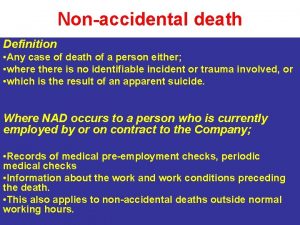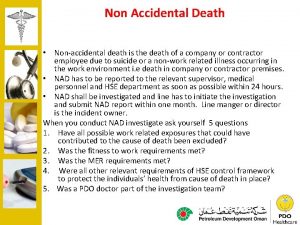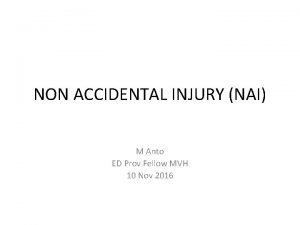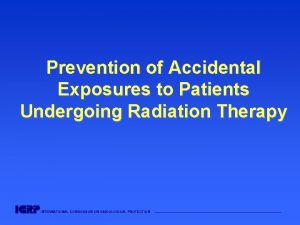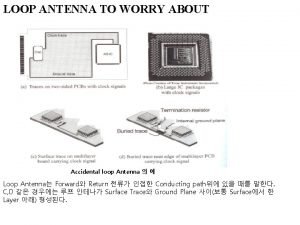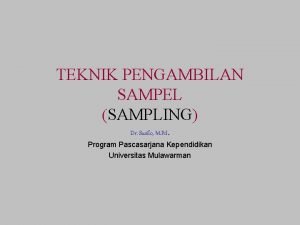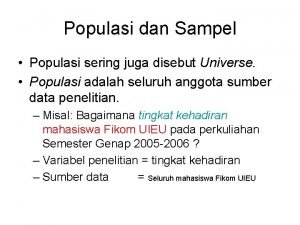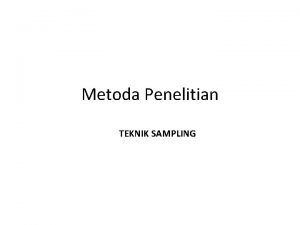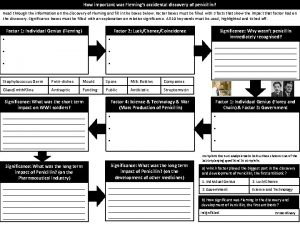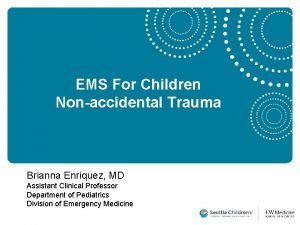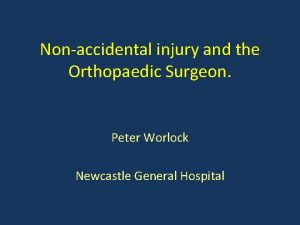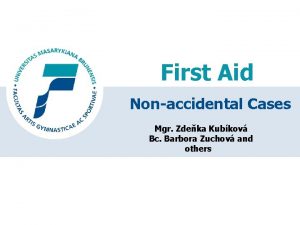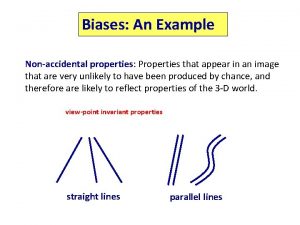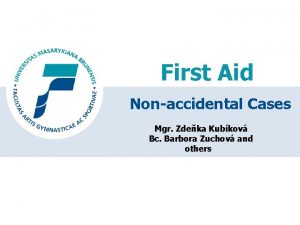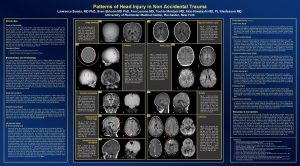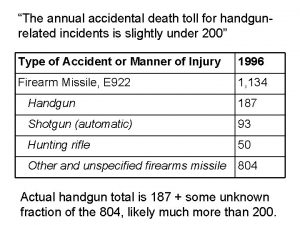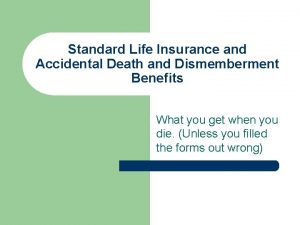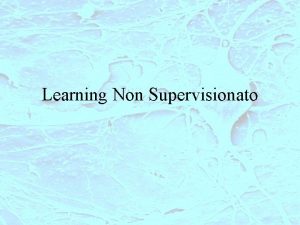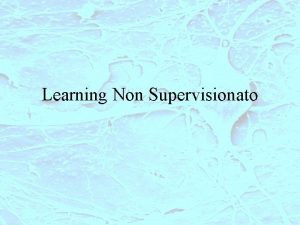Non Accidental Death Nonaccidental death is the death



















- Slides: 19

Non Accidental Death • Non-accidental death is the death of a company or contractor employee due to suicide or a non-work related illness occurring in the work environment i. e death in company or contractor premises. • NAD has to be reported to the relevant supervisor, medical personnel and HSE department as soon as possible within 24 hours. • NAD shall be investigated and line has to initiate the investigation and submit NAD report within one month. Line manger or director is the incident owner. When you conduct NAD investigate ask yourself 5 questions 1. Have all possible work related exposures that could have contributed to the cause of death been excluded? 2. Was the fitness to work requirements met? 3. Was the MER requirements met? 4. Were all other relevant requirements of HSE control framework to protect the individuals’ health from cause of death in place? 5. Was a PDO doctor part of the investigation team?

Non Accidental Death - Examples Case Classification Employee commits suicide at work but due to work related issues Employee commits suicide at work due to personal home pressures Employee falls ill at site but dies later in hospital due to same illness Employee has a non work related illness (e. g. stroke, whilst resting off duty in the work camp Employee dies at home from non work related illness Employee dies from on work related illness whilst in hotel away on business Employee dies from a fatal occupational illness Work fatality NAD related NAD Death in service Work fatality related

Non Accidental Death - Challenges 1. Remain a challenge in PDO concession area, mostly among contracting community 2. No known prior medical condition(s) in 1/2 of the NADs. 3. Most appeared to have valid Ft. W certificates. 4. No significant findings during routine 2 yearly medical. 5. No appropriate follow up chronic medical conditions and health risk factors in Many of the employee. 6. Life style issues, employees denial of medical problems and ignorance of medical advice 7. The common risk factors include smoking, HTN, high cholesterol and diabetes 8. Issues with return to work following significant illnesses.

NAD – Challenges cont. 9. Lack of Proactive leadership by contract holders on OH inadequate in verifying compliance with OH specifications by the contractors (e. g preemployment medicals, medical facilities, HRAs, camps standards etc). 10. Recent observed incidents of suicides. 11. Inappropriate medical facilities in some locations or rigs e. g. 12. Investigations often not solid conclusive with difficulties in conducting autopsy in many cases. 13. MER issues including competence of Contractors’ doctors and nurses, shortage of drugs and MER equipments. 14. Increased size of workforce - Over 55, 000 workforce as oppose to the supervisors/contract holder’s ratio.

The main factors to NADs Challenge Causes 1 Pre-existing conditions HTN, Diabetes, High cholesterol level 2 Individual behaviors and life style issues Lack of exercise, Heavy smoking, Over eating, obesity, etc. 3 Attitude, culture and beliefs issues Bad beliefs, Fears, Ignorance of medical advice and denial. 4 Non-compliance with FTW Standards Issue of appropriate exams. and medical surveillance 5 Issues with return to work medicals Ignorance v/s fear of losing job 6 Occasional no follow up of cases with chronic medical problems. Inappropriate follow up and care of chronic medical conditions 7 Lack of health awareness Language diversity

NAD -Epidemiology q Over 80% are due to massive heart attack or other cardiovascular disease. q 11% unknown q 1% suicide Ø PDO and contractors’ death rate of 0. 49 is well below the national rate of 3. 1. Ø PDO and contractors’ death rate from cardiovascular diseases in 2008 was 0. 35 per 1000 population. Ø The national death rate from cardiovascular diseases was 4. 09 per 1000 population for Oman and 4. 28 per 1000 population for India according to WHO data base.

Percentage distribution of the workforce (PDO and Contractors %Omanis %Expatriates Total Population PDO 77% 23% 6500 Contractors 49% 51% >50000

NAD according to company PDO - 14% Contractor - 86% - 30% Oman - 65% India/Pakistan/Bangladesh - 3% Philippines - 2% Other countries

Non-Accidental Death Cases 1998 -2012 25 20 15 21 10 18 15 17 15 16 13 5 13 11 10 8 8 2001 2002 11 8 7 0 1998 1999 2000 2003 2004 2005 2006 2007 2008 2009 2010 2011 2012

My apologies for late response. NADs Total manhours (mln. ) rate/mln hours 1998 15 59. 31 0. 253 1999 13 52. 81 0. 256 2000 10 51. 62 0. 194 2001 8 48. 47 0. 165 2002 8 53. 39 0. 150 2003 11 60. 87 0. 181 2004 8 67. 21 0. 119 2005 11 64. 26 0. 171 2006 18 78. 84 0. 228 2007 15 99. 62 0. 151 2008 21 127. 06 0. 165 2009 17 147. 07 0. 116 2010 16 147. 93 0. 108 2011 13 141. 24 0. 092 2012 7 149. 15 0. 047 2013 9 158. 49 0. 057


Age distribution of NADs 12 10 8 6 NADs 4 2 0 20 -30 31 -40 41 -50 51 -61

NADs assessment against some demography and MHMS standards (Dr. Sawai review - 2008) No. of NADs Percentages Omanis / Non-Omanis 7 / 14 33. 4% /66. 6% PDO / Contractors 3 / 18 14. 3% / 85. 7% No HRA performed 9 45% Pre-existing medical problems 11 55% Non-compliance to fitness to work (Ft. W) 10 47% Cases with significant life style issues 9 45% Failure to properly follow up chronic medical problems 6 28. 5% Medical emergency response (MER) 5 25%

NAD - PDO Efforts q Over the years PDO has made much efforts in order to improve the well being of its workforce and to address health and lifestyle issues. q These efforts continues today and include: § The appointment of full time Head of OH in 2008 and the recent merger of OH and Medical Dept. as one Health Team – Nov. 2011 which ensures the implementation of Minimal health management STD. § The appointment of full time Public Health Advisor and full time Dietician /nutritionist in 2012 § Improved working and living Conditions(permanent accommodation for contractors, PACs) § Annual 1 month OH Road Shows to educate workers on various health topics including life style § NAD reporting and investigations- All NAD are now being discussed at MDIRC

NAD - PDO Efforts cont. q OH plan § Conducted OH workshop for all HSE managers, Contract holders and PDO/Contractor medical professionals to increase OH awareness, within PDO concession area. § Training of doctors who provide Ft. W medical for contracting workforce and emphasize on the importance of compliance with FTW standards, the medical conditions which affect fitness to work and the follow up of high risk cases. § Just completed 5 days OH course by UAE/Irish University for 30 doctors. § Annual wellness walk and OH road shows in all interior locations. § Continue to play a leading role in OH in Oman. Provide advice, support and training to Mo. H, SQUH graduates.

NAD - PDO Efforts cont. q Dietitian / Nutritional services and wellness program. § The appointment of full time Dietitian to look after dietary aspect of welfare of the workforce by working with catering services to improve healthy diets. The goal is to reduce the increasing trends in lifestyle related medical conditions § Stepped up workplace wellness programs in order to improve the well being of the workforce and to address health and lifestyle issues through health promotion and health education presentation. Over 670 employees received dietetic consultations in 2013. § Introduced in-house exercise facility (GYM) to encourage employee to participate in regular exercise.

PDO Efforts - continue q Public Health and Employees’ Welfare § The appointment of full time Public Health Advisor, and Welfare (Employee assistance program) Officer to support Public Health activities and the welfare of contracting community /workforce. § Improvement of the workforce welfare- PAC accommodation and supervision of camp services and hygiene including catering services. § Review of the work-leave schedule for the contractors’ workforce. (Need enforcement) § Discussion underway to look into providing Employee Assistance Program (EAP) with focus on welfare of contracting community/workforce impacting on health

NAD - PDO Efforts cont. q Medical Emergency Response (MER) § All PDO health professionals are fully versed in MER, trained in ACLS, ATLS, and Exposure to other emergency response experiences. § Procedure in place to ensure all contractors’ nurses and doctors are well versed in MER and have valid ACLS/ ATLS. § Increased number of Designated First Aiders and introduction of the new AHA accredited First Aid course. § New fleet of ambulance is in place and 6 new paramedics have been trained to replace ambulance drivers. § Regular drills (Needs improvements)

2014 planned activities. § Centralization of contractor medical services The phasing out of small clinics manned by single nurse and provide centralized facilities manned by doctors who will be able to follow up chronic medical conditions which increased risk of heart attack and other causes of sudden death. § Stepped up workplace wellness programs with the goal to reduce the increasing trends in lifestyle related medical conditions. This includes the smoking cessation clinic. § Enhanced implementation of smoking, Drug & alcohol policy. § Enhanced implementation evaluation of pre-employment and fitness to work medical evaluation in PDO and contractor workforce.
 Non accidental death definition
Non accidental death definition Non accidental death examples
Non accidental death examples Non accidental injury
Non accidental injury Veux tu briser du péché le pouvoir parole
Veux tu briser du péché le pouvoir parole Accidental whorl
Accidental whorl Accidental
Accidental Accidental insider trading
Accidental insider trading Accidental exposure
Accidental exposure Accidental flash
Accidental flash Accidental loop
Accidental loop Deliberate adulteration examples
Deliberate adulteration examples Accidental plagiarism examples
Accidental plagiarism examples Convenience sampling adalah
Convenience sampling adalah Convenience sampling
Convenience sampling Sampel adalah
Sampel adalah Accidental fingerprint
Accidental fingerprint Rumus slovin adalah
Rumus slovin adalah Se accidental
Se accidental Accidental discovery of penicillin
Accidental discovery of penicillin Tented arch upthrust
Tented arch upthrust
